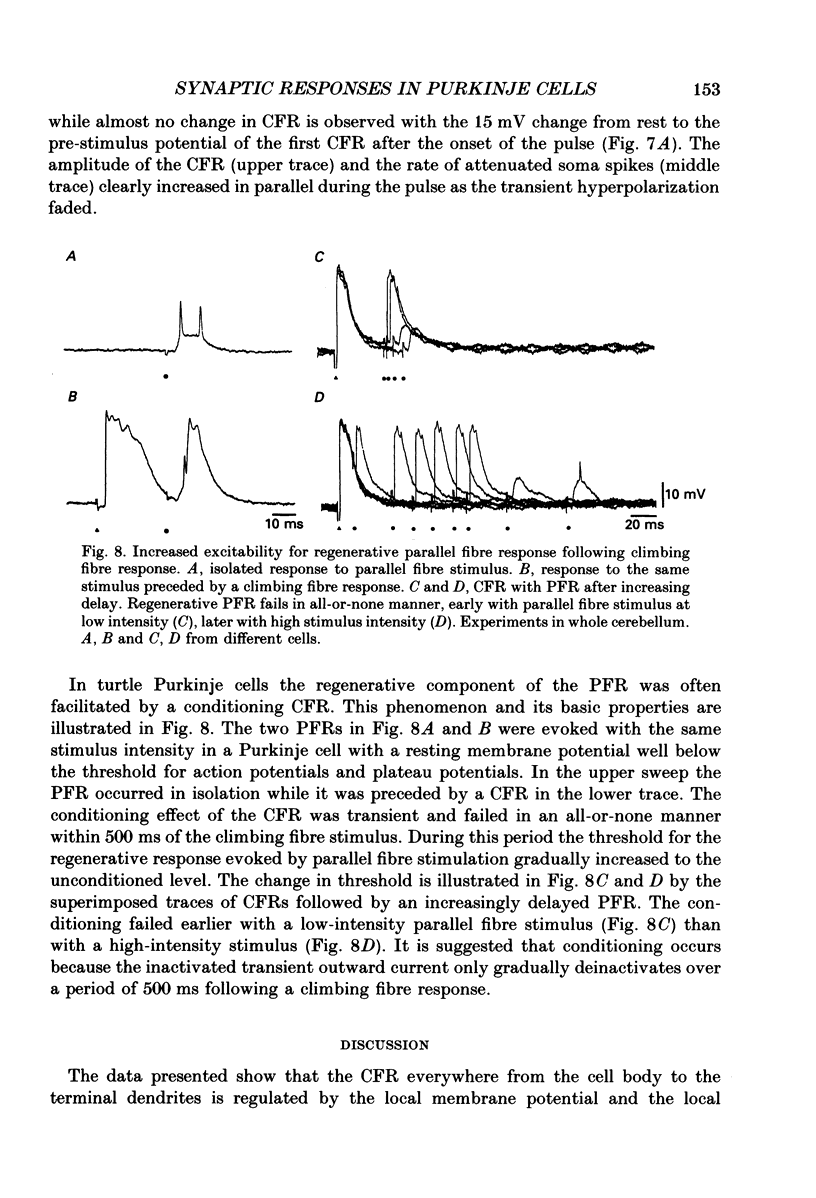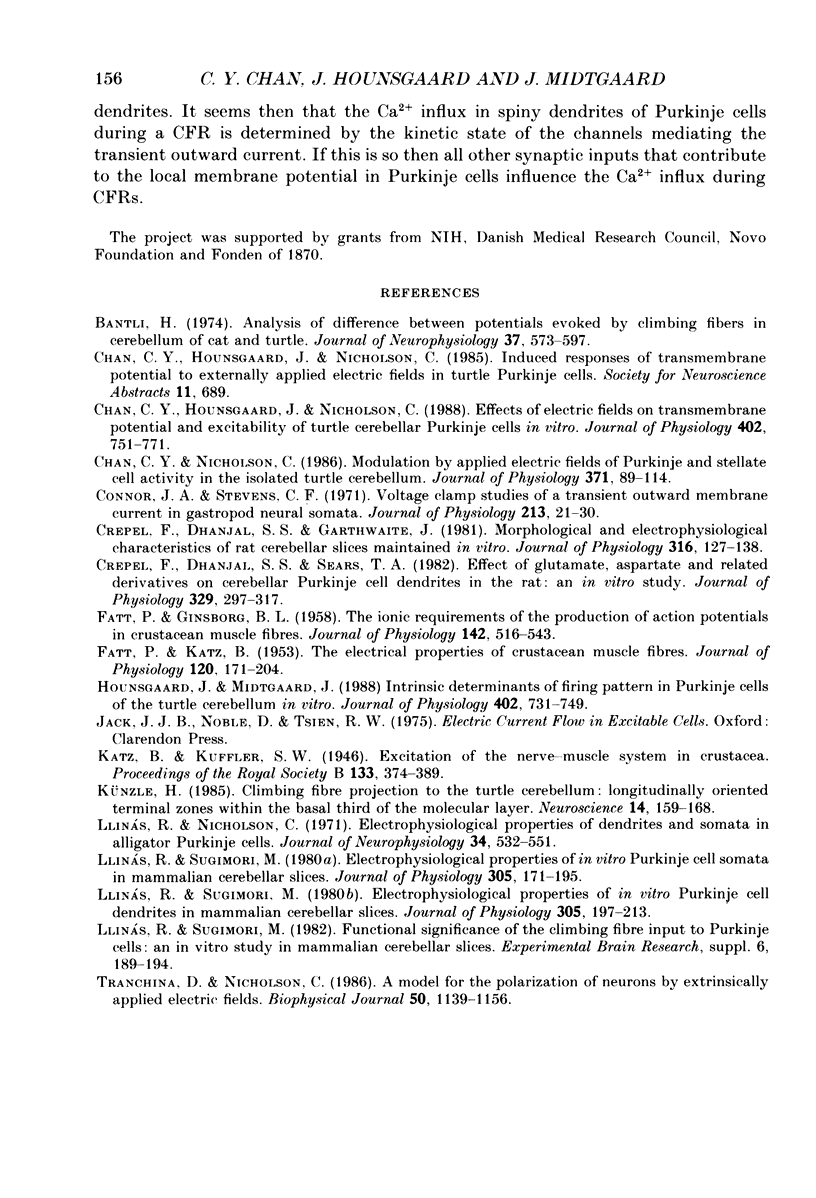Abstract
1. Climbing fibre responses (CFRs) and parallel fibre responses (PFRs) in Purkinje cells have been analysed in intracellular recordings obtained at various levels from cell body to terminal dendrites in the turtle cerebellum in vitro. 2. With increasing stimulus intensity, the PFR recorded in distal dendrites displayed an early regenerative component which was graded at rest and at hyperpolarized membrane potentials, but was all-or-none at depolarized membrane potentials. 3. The all-or-none component had the same characteristics as Ca2+ spikes triggered by passing depolarizing current through the recording electrode. 4. The repolarizing phase of the PFR had a fast component enhanced by depolarization and diminished by hyperpolarization. 5. In the mid-molecular layer the PFR also included a plateau component which was increasingly prolonged by depolarization and abolished by hyperpolarization. 6. CFRs recorded in the soma had a plateau component, prolonged by local depolarization and abolished by local hyperpolarization. 7. The CFR in distal dendrites included a regenerative component. In some cells this component appeared in an all-or-none manner with local depolarization. In other cells it was smoothly graded with local polarization. 8. In mid-molecular records the CFR was prolonged by local depolarization and presumably electrotonically affected by the configuration of the response more distally and proximally in the cell. 9. It is concluded that excitatory synaptic responses in Purkinje cells include a regenerative Ca2+-mediated spike component in the spiny dendrites and a plateau component located in the proximal dendrites and/or the cell body. It is shown that both responses are modulated in configuration by the local membrane potential. In the spiny dendrites activation and inactivation of the transient hyperpolarizing potential appear to govern the Ca2+ influx during the CFR.
Full text
PDF













Selected References
These references are in PubMed. This may not be the complete list of references from this article.
- Bantli H. Analysis of difference between potentials evoked by climbing fibers in cerebellum of cat and turtle. J Neurophysiol. 1974 Jul;37(4):573–593. doi: 10.1152/jn.1974.37.4.573. [DOI] [PubMed] [Google Scholar]
- Chan C. Y., Hounsgaard J., Nicholson C. Effects of electric fields on transmembrane potential and excitability of turtle cerebellar Purkinje cells in vitro. J Physiol. 1988 Aug;402:751–771. doi: 10.1113/jphysiol.1988.sp017232. [DOI] [PMC free article] [PubMed] [Google Scholar]
- Chan C. Y., Nicholson C. Modulation by applied electric fields of Purkinje and stellate cell activity in the isolated turtle cerebellum. J Physiol. 1986 Feb;371:89–114. doi: 10.1113/jphysiol.1986.sp015963. [DOI] [PMC free article] [PubMed] [Google Scholar]
- Connor J. A., Stevens C. F. Voltage clamp studies of a transient outward membrane current in gastropod neural somata. J Physiol. 1971 Feb;213(1):21–30. doi: 10.1113/jphysiol.1971.sp009365. [DOI] [PMC free article] [PubMed] [Google Scholar]
- Crepel F., Dhanjal S. S., Garthwaite J. Morphological and electrophysiological characteristics of rat cerebellar slices maintained in vitro. J Physiol. 1981 Jul;316:127–138. doi: 10.1113/jphysiol.1981.sp013777. [DOI] [PMC free article] [PubMed] [Google Scholar]
- Crepel F., Dhanjal S. S., Sears T. A. Effect of glutamate, aspartate and related derivatives on cerebellar purkinje cell dendrites in the rat: an in vitro study. J Physiol. 1982 Aug;329:297–317. doi: 10.1113/jphysiol.1982.sp014304. [DOI] [PMC free article] [PubMed] [Google Scholar]
- FATT P., GINSBORG B. L. The ionic requirements for the production of action potentials in crustacean muscle fibres. J Physiol. 1958 Aug 6;142(3):516–543. doi: 10.1113/jphysiol.1958.sp006034. [DOI] [PMC free article] [PubMed] [Google Scholar]
- FATT P., KATZ B. The electrical properties of crustacean muscle fibres. J Physiol. 1953 Apr 28;120(1-2):171–204. doi: 10.1113/jphysiol.1953.sp004884. [DOI] [PMC free article] [PubMed] [Google Scholar]
- Hounsgaard J., Midtgaard J. Intrinsic determinants of firing pattern in Purkinje cells of the turtle cerebellum in vitro. J Physiol. 1988 Aug;402:731–749. doi: 10.1113/jphysiol.1988.sp017231. [DOI] [PMC free article] [PubMed] [Google Scholar]
- Künzle H. Climbing fiber projection to the turtle cerebellum: longitudinally oriented terminal zones within the basal third of the molecular layer. Neuroscience. 1985 Jan;14(1):159–168. doi: 10.1016/0306-4522(85)90171-x. [DOI] [PubMed] [Google Scholar]
- Llinas R., Nicholson C. Electrophysiological properties of dendrites and somata in alligator Purkinje cells. J Neurophysiol. 1971 Jul;34(4):532–551. doi: 10.1152/jn.1971.34.4.532. [DOI] [PubMed] [Google Scholar]
- Llinás R., Sugimori M. Electrophysiological properties of in vitro Purkinje cell dendrites in mammalian cerebellar slices. J Physiol. 1980 Aug;305:197–213. doi: 10.1113/jphysiol.1980.sp013358. [DOI] [PMC free article] [PubMed] [Google Scholar]
- Llinás R., Sugimori M. Electrophysiological properties of in vitro Purkinje cell somata in mammalian cerebellar slices. J Physiol. 1980 Aug;305:171–195. doi: 10.1113/jphysiol.1980.sp013357. [DOI] [PMC free article] [PubMed] [Google Scholar]
- Tranchina D., Nicholson C. A model for the polarization of neurons by extrinsically applied electric fields. Biophys J. 1986 Dec;50(6):1139–1156. doi: 10.1016/S0006-3495(86)83558-5. [DOI] [PMC free article] [PubMed] [Google Scholar]


